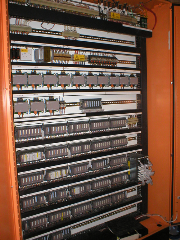 Solutions from Siemens have aided a building controls upgrade at the Natural Environment Research Council’s (NERC), National Oceanography Centre in Southampton.
Solutions from Siemens have aided a building controls upgrade at the Natural Environment Research Council’s (NERC), National Oceanography Centre in Southampton.
The facility is at the forefront of research in the fields of marine and earth sciences. As such, with such an environmental focus, it is important that the facility has a sustainable environment in which to undertake its research.
NERC appointed Siemens Solution Partner, Matrix Sustainable Energy Efficiency, to begin a programme of upgrading the dated building energy management controls on site. The works commenced in December 2009 and thorough project management was needed to ensure minimal impact on services and personnel. The legacy system has been replaced with Siemens PXC controls and Desigo V4.1 headend PC software, to ensure effective and simple monitoring of the building energy management system (BEMS).
The upgrade programme was designed to overcome legacy issues associated with obsolete equipment and to ensure optimum energy efficiency at the site. However, it was crucial that all upgrade work was conducted with minimal impact on the site, which needed to continue functioning as a leading research centre with staff, students and visitors all needing access. To ensure disruption was kept to a minimum, a dedicated on-site team from Matrix Sustainable Energy Efficiency worked in close partnership with the Facilities Management Team at the National Oceanography Centre. This approach ensured the research undertaken on-site could continue without interruption in alliance with Cudd Bentley Consulting and Project Managers, NDA Consulting – BEMS Consultants and NERC operatives.
From the outset, the programme of upgrade activity was devised with the Centre’s Facilities Management Team and this laid out where the upgrades would take place, how long they would take and what the effects or restrictions for personnel would be. By defining where and when work would take place, it was easier for clear communication to be issued to staff and visitors. This was particularly important in critical areas such as laboratories, fume cupboards and clean rooms.
Throughout the works, every effort was made to ensure that staff were kept informed as to what was next in the controls upgrade programme. This ensured site disruption was kept to an absolute minimum and up to date communication could be shared.
Paul Murphy, regional manager for Matrix South East, commented, “There are over 50 individual control panels requiring systematic upgrading as part of this project. During the course of the upgrade works, temporary wiring modifications to individual control panels had to be incorporated to ensure essential equipment remained operational during the controls upgrade process, thus ensuring minimal disruption to services and personnel.
 “The original AS1000 controls and associated backplates were removed in their entirety and replaced with brand new control backplates including new Siemens PX controls which were manufactured and fully function tested prior to installation. The advantage of this upgrade methodology is that it ensures system downtime is kept to a minimum and full detailed wiring and operations and maintenance (O&M) documentation is submitted to ensure future maintainability.
“The original AS1000 controls and associated backplates were removed in their entirety and replaced with brand new control backplates including new Siemens PX controls which were manufactured and fully function tested prior to installation. The advantage of this upgrade methodology is that it ensures system downtime is kept to a minimum and full detailed wiring and operations and maintenance (O&M) documentation is submitted to ensure future maintainability.
“Wherever possible, the original control strategy on-site has been enhanced to give further energy savings. Where we have seen opportunities for energy efficiency improvements, we’ve implemented measures to ensure these can be benefited from. Direct Modbus integrations with the generator and UPS panels have also been incorporated as part of the upgrade works to ensure total visibility of essential services.
“The use of Siemens Desigo V4.1 headend PC software means the PCs used to monitor the BEMS have also been given additional functionality and easy to use full graphics. These enhancements ensure that up to five concurrent users can monitor the system effectively.”
Lewis Rennison, head of facilities at National Oceanography Centre, commented, “The upgrade works have been a great success to date. The enhancements to the BEMS mean we have increased visibility of plant and alarms. Also, the alarms have been further categorised and functionality enhanced, so we can monitor the system more effectively and see where there are errors or cause for concern and act swiftly to ensure minimal impact on the energy efficiency of the site.
“The site’s energy efficiency has also been boosted by the identification of non operational or passing valves which have been rectified to reduce unnecessary energy consumption on-site.
“The project is due to complete in August 2012, so we will be able to establish the total energy savings the project has achieved. So far we have been very pleased with the efficiency of the upgrades and the collaboration between our team and Matrix Sustainable Energy Efficiency.”
NERC has been awarded the Carbon Trust Standard for making year on year carbon savings. The efficiency improvements made through this project will help sustain carbon savings into the future.


